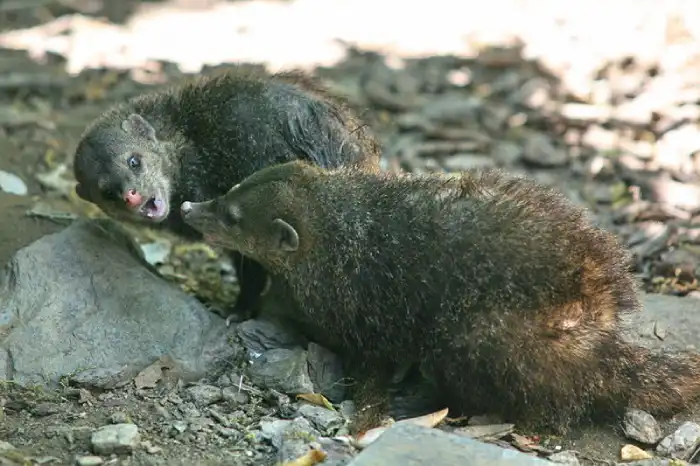Meerkats are charming animals, famous for their scanning of the horizon for danger, posing for the National Geographic cameras, and one Disney cartoon character called Timon.
These small mammals have some distinctive looks: slender bodies, pointy little faces, tiny ears, and black eye patches. But are there animals that remind us of them?
Examples of animals that look like meerkats include the banded and yellow mongoose, ferrets, weasels, minks, raccoons, prairie dogs, and many others.
Let’s dive in and describe all of these meerkat-looking animals so you know how to better differentiate them next time.
Table of Contents
What Does A Meerkat Look Like?

Meerkats are small gray animals found in Southern Africa. They have pointy snouts, long legs, large eyes, and dark to grizzled light gray coats. Their tails are slim and yellowish and their sharp, curved claws are well-adapted for digging.
Animals That Look Like Meerkats
Banded Mongoose
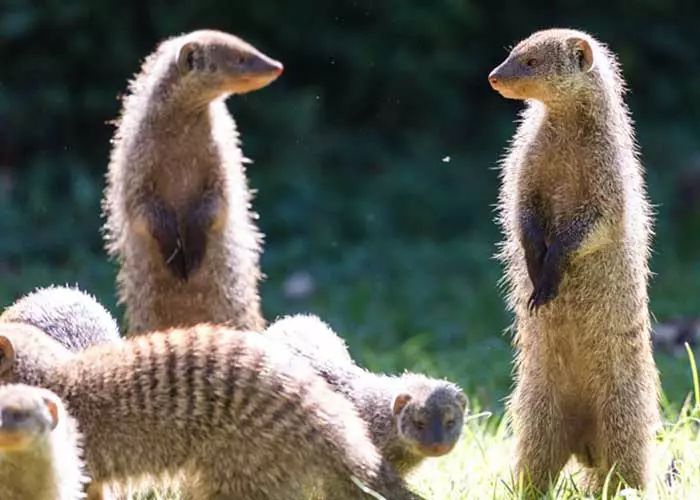
Size: 14 in
Weight: 2.8 lb
Diet: Carnivore
Found In: Africa
The banded mongoose is a greyish member of a large mongoose family that lives in savannas, open forests, and grasslands of Africa. A banded mongoose and a meerkat both look alike due to their pointy noses and small ears. In fact, if you ask us, they are just fluffier, angrier, grayish versions of meerkats.
You can differentiate the two by size: meerkat is smaller, has a shorter tail, and has more prominent eyes compared to the head size.
Banded mongooses are nomadic creatures that like to move a lot: every 3-4 days they will change their place.
They are excellent snake killers and just like Joey from the show Friends, banded mongooses do not share food – they are very possessive of it.
Banded mongooses are very social creatures that live in groups of up to 40, with one dominant male leading the pack.
Yellow Mongoose
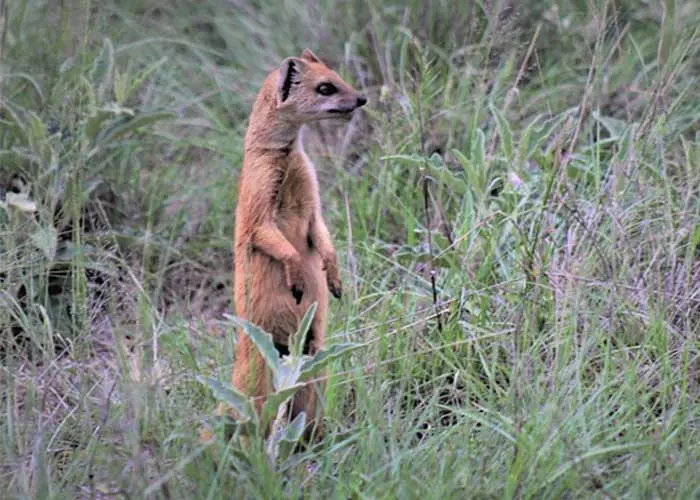
Size: 11 in
Weight: 1.3 lb
Diet: Carnivore
Found In: Africa
The yellow mongoose is a small meerkat-looking mammal that can be found in open country, semi-desert scrubland, and grasslands of South Africa.
And just like a meerkat, it has a pointy nose, small ears, and long curved claws for digging. People will sometimes refer to yellow mongooses as red meerkats, due to many shared similarities between the two.
The main difference between a yellow mongoose and a meerkat is the tail and color: mongooses have bushier tails and lighter coat colors.
Yellow mongooses are excellent diggers – they will make a series of underground tunnels with over 40 entrances, chambers, and tunnels. They are carnivores that eat amphibians, reptiles, beetles, ants, mice, and even birds.
There are around 30 species of mongoose currently alive; they are all closely related to meerkats so it’s no wonder they all look like. Meerkats and mongooses are members of the same Herpestidae family.
Some mongoose species that are closely related to meerkats are the banded, Gambian, Liberian, common dwarf mongooses, and several species of kusimanse.
Ferret

Size: 15 in
Weight: 1.5-4.4 lb
Diet: Carnivore
Found In: North America, Africa, and Europe
Ferrets are small furry creatures with long bodies, short legs, small ears, and small heads that live in grassy plains in the wild. Due to their similar body shape and eye patches, it would be easy to mistake a ferret for a meerkat in the field.
Ferrets got domesticated some 2,500 years ago. Just like meerkats, they are carnivores. In the wild, ferrets will feed on raw meat, raw bones, and other tissue.
They got their name from the Latin word “furittus” which means “little thief.” Depending on the coat type, size, color, or pattern, there are over 20 types of ferrets.
A group of ferrets is known as a “business”.
Weasel
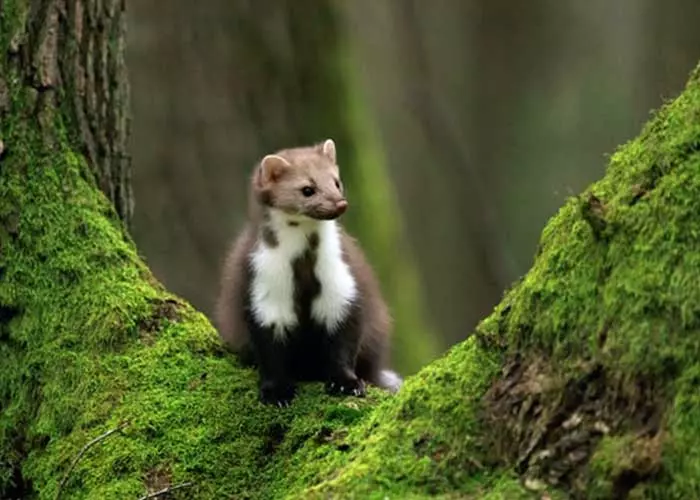
Size: 4-10 in
Weight: 1 oz
Diet: Carnivore
Found In: Worldwide
Weasels, just like meerkats, have a slim, elongated body, and a small head. Tiny, rounded ears, large eyes, and a pointy snout are what make them look similar. They can be found in the open fields, woodlands, thickets, roadsides, and farmlands.
Weasels might look cute, but they are ferocious predators. Often, they will attack prey larger than themselves, and kill much more than they can eat. They do not throw leftovers; they feast on them in the following days.
When trapped, weasels will hit their enemy with a stink bomb – a thick, oily, yellowish fluid that reeks.
Read More: Weasel species found in Michigan
Mink
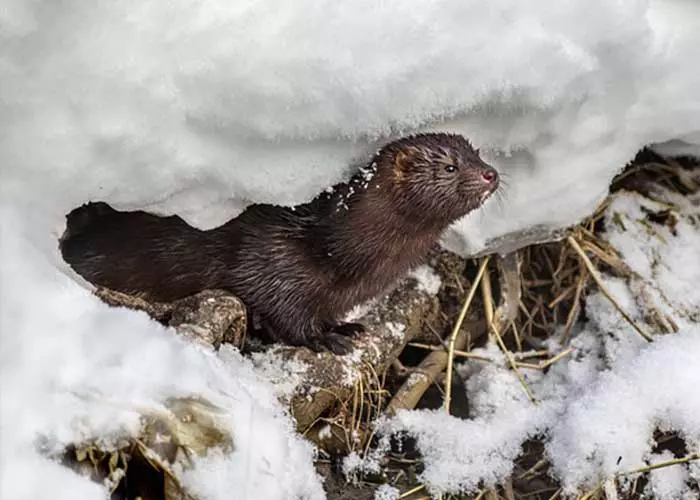
Size: 13-18 in
Weight: 1.1-3.5 lb
Diet: Carnivore
Found In: North America, Europe, and Asia
The mink is a small semiaquatic mammal that resembles a meerkat and lives in North America and Eurasia. Minks are animals often found near lakes and rivers when there’s a tree cover nearby. They have elongated and thin bodies, short legs, pointed snouts, and sharp claws.
Minks are excellent diggers, swimmers, and climbers – they can swim up to 100 feet underwater and jump from tree to tree. When they are happy, minks will purr.
Despite looking cute, these brown animals are excellent predators that kill their prey with a bite to the neck. Minks feed on muskrats, rabbits, mice, chipmunks, fish, snakes, frogs, and birds.
Some people confuse them for rodents, but minks do not belong to the rodent family of animals.
Read more: Do bears reek?
Marmot
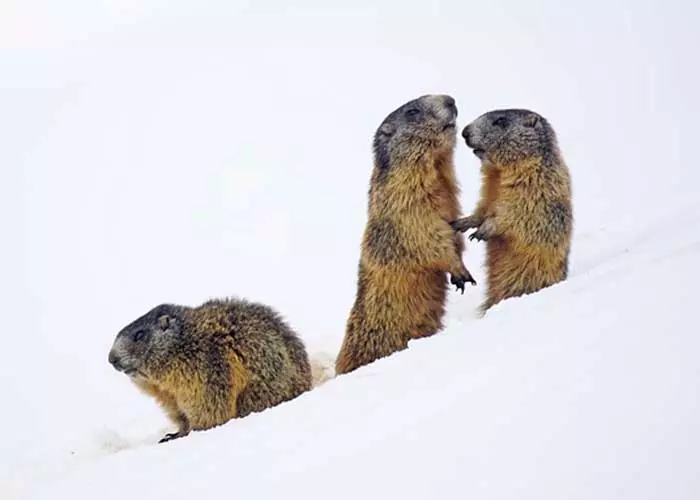
Size: 17-28 in
Weight: 6-15 lb
Diet: Herbivore
Found In: Asia, Europe, and North America
Marmots are large, heavily-built animals that live in mountain regions of Europe, North America, northwest Asia, Pakistan, and India.
And if you ask us, marmots are just meerkats that have been eating too much food. Both look alike, both have prominent eyes on their heads, round ears, and sharp claws. Marmots are, of course, a lot bigger than meerkats.
Marmots are a large group of rodents that consists of 15 species (including groundhogs). All of these animals like to live in their burrows – during winter they hibernate there.
Both the meerkats and marmots can be often seen on their back legs looking for predators (hence the confusion in their looks), and when they spot one, they will release a warning sound – meerkats let out a distinctive bark while marmots whistle loudly.
Raccoon

Size: 16-28 in
Weight: 8-20 lb
Diet: Omnivore
Found In: North America
Raccoons are grey-coated mammals native to North America that bear some resemblance to meerkats – both have long snouts and patches around their eyes. Raccoons can be found in moist woodland areas, farmlands, suburban, and urban areas.
They are well-known for their bandit-like facial mask and similarly bandit-like behavior – they’re curious scavengers and opportunists that love stealing food and different items.
Raccoons got their name from the Powhatan word “aroughcun”, meaning “animal that scratches with its hands.”
Despite sharing some physical traits, meerkats and raccoons are not related. Meerkats are members of the mongoose family while raccoons are members of the Procyonidae family, together with ringtails, cacomistles, coatis, kinkajous, olingos, and olinguitos.
Prairie Dog
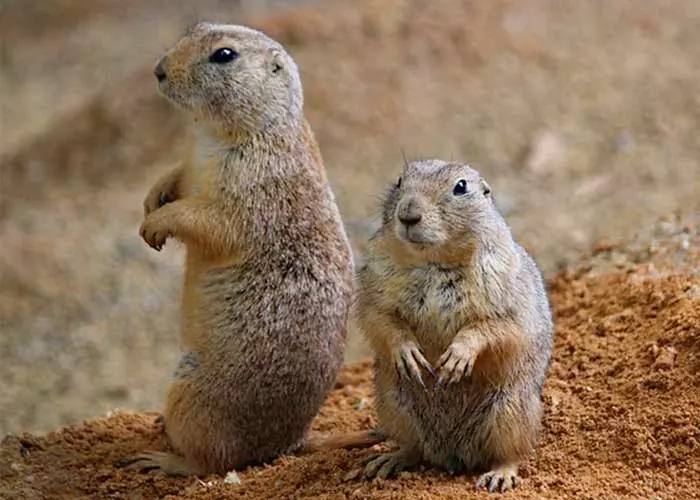
Size: 12-15 in
Weight: 2-4 lb
Diet: Herbivore
Found In: North America
Prairie dogs are small and furry animals that resemble meerkats a bit. They have a short tail, small rounded ears, and short legs. Prairie dogs live in dry grasslands, at altitudes ranging from 2,000 to 10,000 ft above sea level.
Prairie dogs mate only once a year – females get into heat for a single hour. Males, no pressure.
Prairie dogs got their name from the prairie they live in and because of their warning calls that sound like barks.
Just like the meerkats, prairie dogs will be on the lookout for predators. When “scouts” spot something while the others are browsing, prairie dogs will release a loud alarm bark so the others run to the safety of the burrow.
Similar to what llamas do – they scream to warn other animals if they see a predator.
Read More: List of animals similar to a prairie dog
Badger
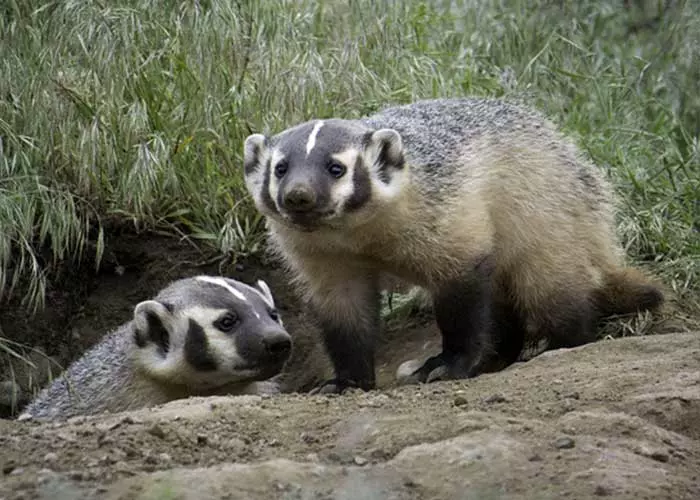
Size: 18-22 in
Weight: 13-25 lb
Diet: Omnivore
Found In: North America
The badger is a small mammal covered in fur that has short legs and a low profile. What makes it resemble meerkats the most, is the small and pointed head. Badger can be found in plains and prairies, farmlands, and the edges of woods.
These animals are excellent diggers that make underground burrows for protection and sleeping. Male and female American badgers are promiscuous and will have multiple partners.
There are 11 species of badgers in total.
Read More: 13 animals that have pointy ears
Common Kusimanse
Size: 13 in
Weight: 2.2 lb
Diet: Carnivore
Found In: Africa
Common kusimanses, long-nosed kusimanses, or simply kusimanses, are small African animals that also share many similarities with meerkats.
These highly social animals love to live in groups of 10-20+ individuals with a strict hierarchical structure.
Common kusimanses have thick brown coats, long snouts, stiff tails, short ears, and short legs. Despite being able to climb trees, common kusimanses stick to the ground.
A highly territorial species, they use scent glands to mark their area, not shying away from fighting even bigger animals that trespass.
Unlike other members of the mongoose family, common kusimanses are found in open grasslands where they feed on small rodents, insects, larvae, small reptiles, and crabs. Thanks to their well-developed eyesight and sense of smell, these active animals make great hunters.
Fossa
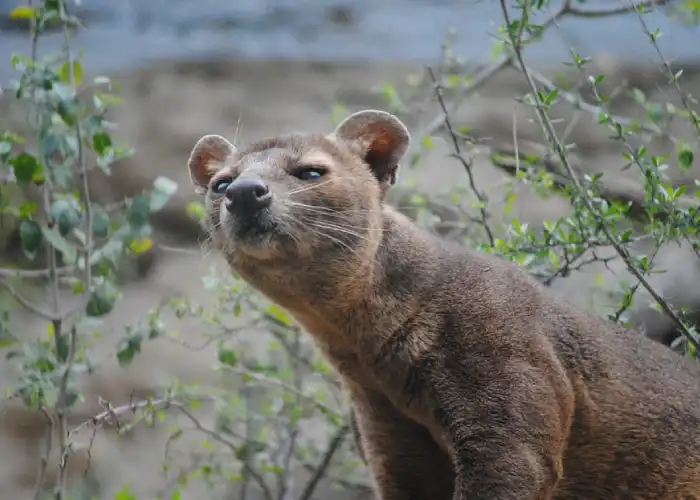
Size: 28–31 in
Weight: 12-19 lb
Diet: Carnivore
Found In: Madagascar
At first glance, fossas look like some kind of a mix of cat, meerkat, monkey, and weasel.
These slender animals are only found in Madagascar and their weight of up to 19 pounds makes them the largest mammalian carnivores there.
Fossas are common around habitats with trees where they hunt both by day and night. Their main prey is lemurs, rodents, birds, and tenrecs.
Due to habitat loss and declining population, the IUCN has listed them as Vulnerable.
Common Dwarf Mongoose
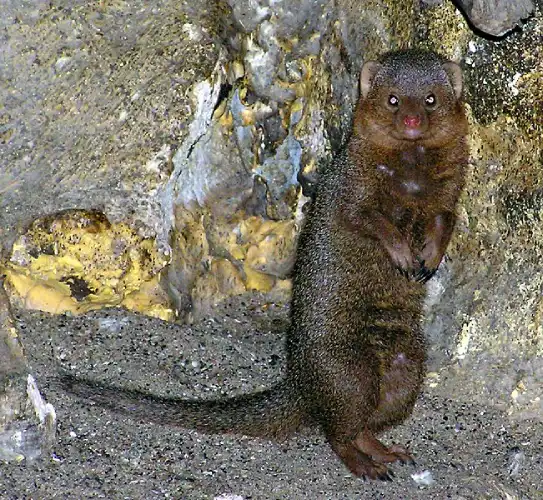
Size: 7.1–11 in
Weight: 11 oz
Diet: Omnivore
Found In: Africa
One of the smallest of the African mongooses, these animals share several characteristics in looks with meerkats. Both have fairly short and pointed muzzles, long tails, and small ears.
Common dwarf mongoose can range from yellowish-red to brown in color and can be seen around woodlands, savannahs, and mountain scrubs.
They live in groups of 12 to 32 animals that are ruled by dominant females. Common dwarf mongooses spend most of their day in pursuit of food, feeding on insects, spiders, scorpions, small vertebrates, snakes, and fruit.
California Ground Squirrel

Size: 12 in
Weight: 0.6-1.6 lb
Diet: Omnivore
Found In: North America
California ground squirrels are small rodents of the squirrel family that live on the ground rather than in trees.
Also known as Beechey ground squirrels, they are found in the western USA and the Baja California Peninsula. California ground squirrels resemble meerkats a bit as they are similar in size; squirrels also have short legs, claws, grayish coats, and small rounded ears.
They prefer to live in open areas, rocky outcrops, fields, pastures, and wooded hillsides. They are omnivorous animals that feed on fungi, nuts, fruits, seeds, occasionally insects, eggs, and other small animals.
Ground squirrels will excavate and live in burrows. In parts of the country with lots of snow, they might hibernate for several months. Due to their habit of eating ornamental plants and trees, people consider California ground squirrels as pets.
Besides California ground squirrel, there are over 60 species of these long-bodied terrestrial rodents that are active during the day.
Rufous Bettong

Size: 15.3 in
Weight: 5.5-7.7 lb
Diet: Herbivore
Found In: Australia
Rufous bettong or rufous rat-kangaroo is an animal similar to a meerkat. They are a solitary species native to eastern Australia.
These small meerkat-like animals have shaggy gray fur with pale gray underparts, short muzzles, and back limbs longer than the front ones. They move by placing the front legs on the ground and bringing the back legs together, but might also hop like kangaroos.
Rufous bettongs inhabit dry open woodlands, wet sclerophyll forests, and coastal eucalypt forests where they feed on fungi, herbs, roots, and tubers.
During the day, they will spend time in shallow ground “nests”. Rufous bettongs are most active during the night and similar to other marsupials, they carry their young in a pouch.
Chipmunk
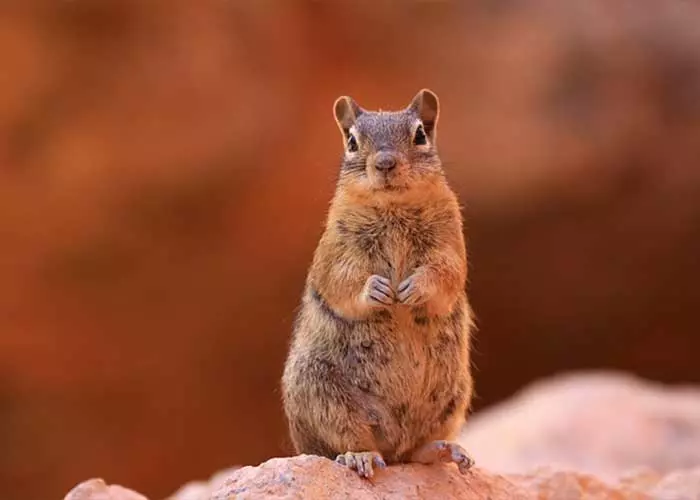
Size: 7-8.5 in
Weight: 2.3–5.3 oz
Diet: Omnivore
Found In: North America
Chipmunks are small members of the squirrel family and the last on our list of animals that resemble meerkats. Chipmunks have large, glossy eyes and pointy whisker-covered noses.
These meerkat lookalikes can be found in forests, forest edges, and areas of thick brush. Chipmunks are omnivores and feed on insects, nuts, berries, seeds, fruit, and grain which they stuff into their cheek pouches and bring to their burrow.
Final Thoughts
There you have it, 15 animals that look like meerkats.
Some look more like meerkats, while for the others, you will need a bit more imagination to spot the resemblances. Mongooses, weasels, ferrets, mink, prairie dogs, and badgers are just a few that are easy to mistake for a meerkat.
Read more: Birds that have split tails and Animals that resemble buffalos
